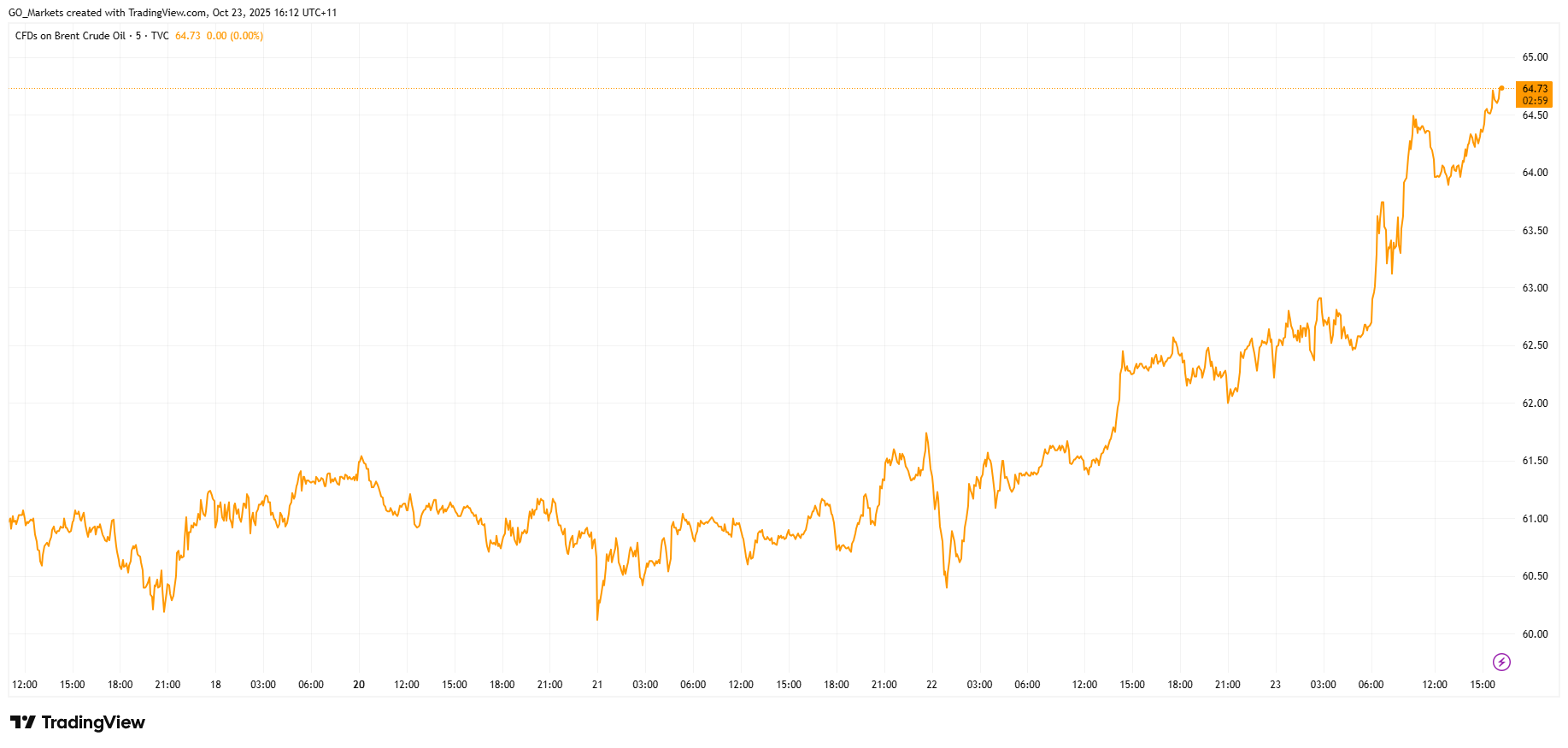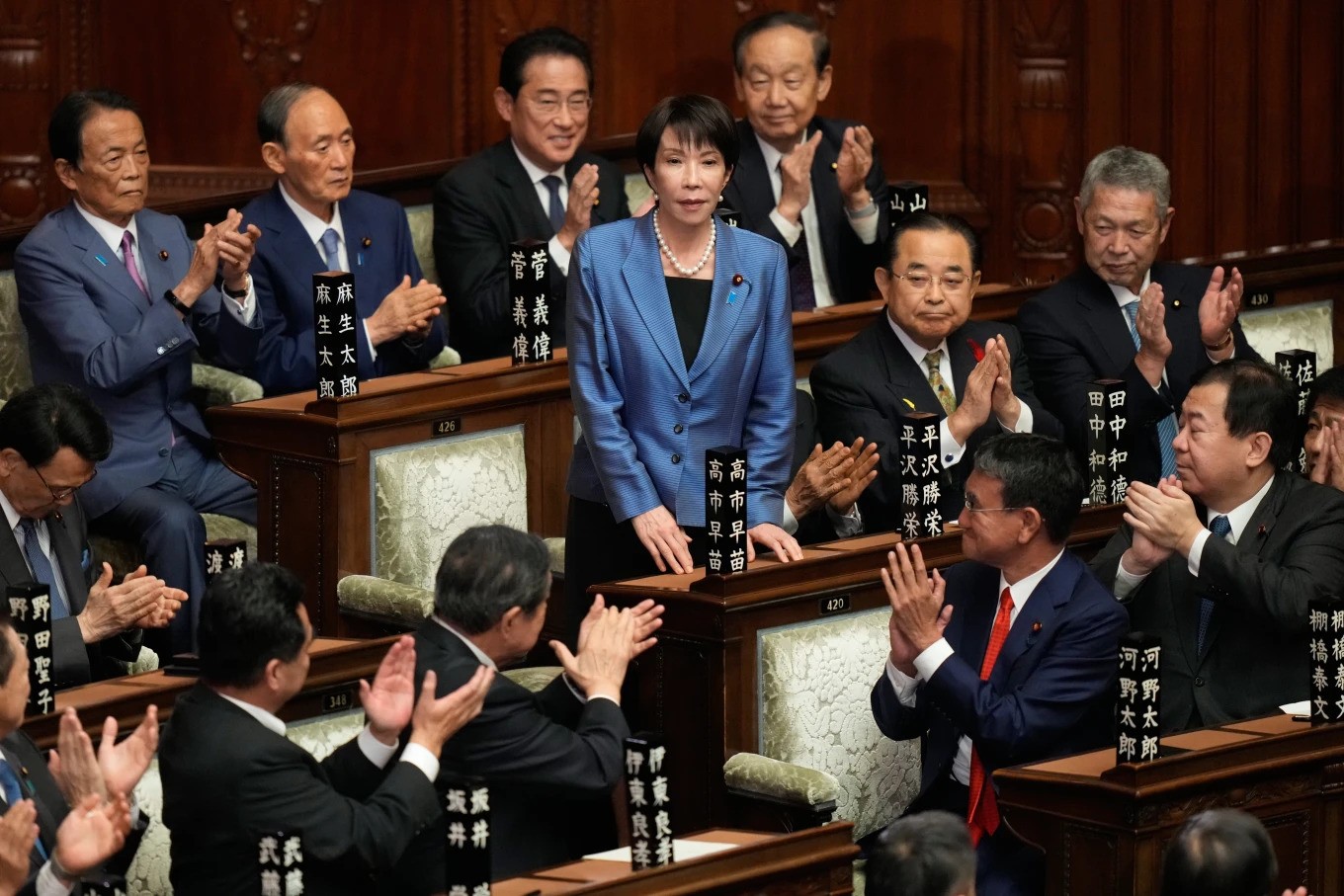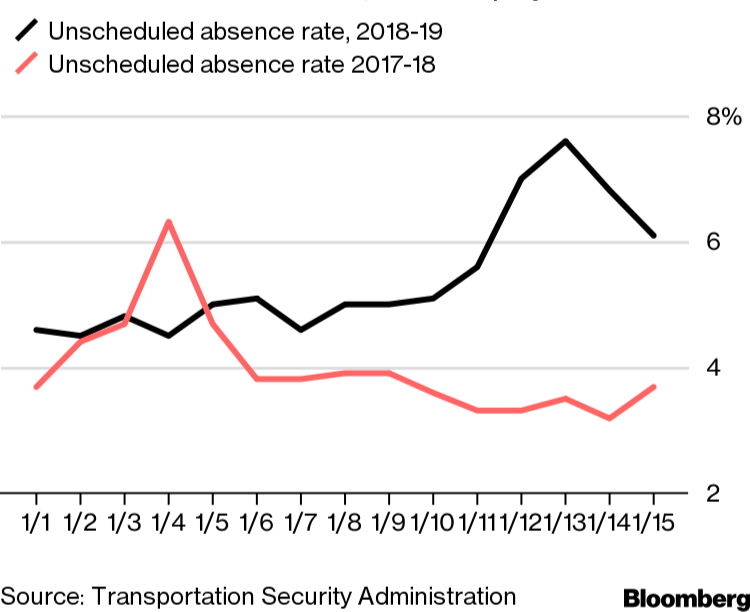市场资讯及洞察

New U.S. Sanctions on Russia as Putin Conducts Nuclear Tests
The U.S. has imposed new sanctions on Russia's two largest oil companies, Rosneft and Lukoil, after planned peace talks between Trump and Putin collapsed on Wednesday.
Oil prices spiked 3% after the announcement, with Brent crude hitting $64 per barrel.

The targeted companies are among the world's largest energy exporters, collectively shipping about three million barrels of oil daily and accounting for nearly half of Russian production.
The sanctions build on recent European measures, as the UK targeted the same companies last week and the EU approved its own sanctions package on Wednesday.
In a show of force coinciding with the new sanctions, Putin supervised strategic nuclear exercises on Wednesday involving intercontinental ballistic missile launches from land and submarine platforms.
While the Kremlin emphasised these were routine drills, the highly coincidental timing is notable.
For markets, the key question now is whether secondary sanctions will follow, and if Trump’s enforcement remains strict. Traders will watch closely for any TACO signals that see Trump ease pressure in an attempt to restart negotiations.
Historic PM Wasting No Time on Celebrations
Sanae Takaichi made history this week as Japan's first female Prime Minister. The 64-year-old conservative leader, dubbed the "Iron Lady,” is already rolling out an aggressive policy agenda that could reshape Japan's economic and geopolitical position.
Her first major move is an economic stimulus package expected to exceed US $92 billion. The package includes abolishing the provisional gasoline tax and raising the tax-free income threshold from ¥1.03 million ($6,800), moves designed to put more money in consumers' pockets and battle inflation.

Her next move will come when Trump arrives in Tokyo next week, as the Japanese government is finalising a purchase package including Ford F-150 pickup trucks, US soybeans, and liquefied natural gas as sweeteners for trade talks.
Takaichi has campaigned on being a champion for expansionary fiscal policy, monetary easing, and heavy government investment in strategic sectors, including AI, semiconductors, biotechnology, and defence.
Critical Workers to Miss First Paycheck Due to Shutdown
The U.S. government shutdown is on the verge of creating a crisis for aviation safety, with 60,000 workers set to miss their first full paycheck this week.
These essential workers, who earn an average of $40,000 annually, already saw shortened paychecks last week. By Thursday, many will receive pay stubs showing zero compensation for the coming period, forcing impossible choices between basic necessities and reporting to work.
During the last extended shutdown, TSA sick-call rates tripled by Day 31, causing major delays at checkpoints and reduced air traffic in major hubs like New York — disruptions which are directly attributed to pressuring the end of the previous shutdown.

The National Air Traffic Controllers Association warns that similar pressures are building, with many workers soon to be facing a decision between attending their shift or putting food on the table.


In the words of one of the greatest supporting roles of all-time, this being Rafiki from the Lion King – It is time, (finally). We understand this is a bit tongue and cheek but the amount of false starts in 2024, we think it sums up what traders have been experiencing. So, we have reached the other side of the mountain.
The cuts are coming. The question now is by how much and how often. It is this question that we traders now need to address.
First let’s look to Thursday's September Federal Open Market Committee (FOMC) meeting. Current market pricing has the FOMC reducing the target range for the federal funds rate by 43 basis points, which puts the probability of a 50-basis point cut in the range of 65 to 70 per cent. This would bring the Federal Funds rate to 4.75 per cent from 5.00 per cent.
The consensus from the economic community also points to a 50-basis point cut. However, the number of 50-basis point worth of cuts versus 25-basis point worth of cuts sits at 24 to 20 suggesting a more conservative view than the headline figure. Our two cents on this using the recent communications from the Fed and barring more severe economic deterioration, we think the Committee will likely opt for a series of 25 basis point cuts going forward including Thursday’s meeting.
What is not disputed is whatever they do on Thursday it’s likely to be the beginning of a series of rate reductions aimed at recalibrating monetary policy to better align with evolving economic conditions – which as we have discussed over the last few weeks is pretty gloomy. So who is right on Thursday’s meeting and what else can we traders take out of the current FOMC environment. All the Talk – nothing is linear The future trajectory of US monetary policy will depend on several changing factors, labour market dynamics being the biggest one.
Take Federal Reserve Governor Christopher Waller’s recent remarks that emphasised the uncertainty surrounding the pace and total amount of rate cuts. He highlighted that these decisions will be data-driven and measured. While he believes “it is time” to begin cutting rates, the start should be a modest reduction as the data, while suggesting things are poor, are not flashing red.
He also remains cautious about making any definitive projections regarding the pace of future cuts. This is important for us – the market is basically pricing in an almost linear decline in rates through to August next year. Waller thinks it isn’t that clear cut - as he distinguishes between "softening" which it currently is doing in the labour market and a "deterioration” which would be out and out capitulation.
This suggests that aggressive action (such as 50 basis point rate cuts) would only be considered if there is a notable and sustained decline in employment. Now if we take Waller’s comments and marry them with New York Fed President John Williams as a clearer picture of the board’s thinking emerges. Williams uses the term "dial down" to describe the gradual reduction of rates and stressed that policy adjustments should move "to a more neutral setting over time." This is not the language of a Board considering hard and fast action on monetary policy.
Rather one that is looking for a steady, deliberate process. Which brings us to one of the more dovish players on the Board San Francisco Fed President Mary Daly’s – have a look at these words when asked about rate cuts: "regular cadence" in adjustments, this aligns with Waller and Williams remarks and suggest the expectation of a methodical approach rather than abrupt shifts is the better trading view. Now there are some caveats to what we have just presented.
Waller did not entirely rule out the possibility of larger cuts particularly if there was a sharp labour market contraction. The current economic outlook does not suggest such a drastic deterioration in the labour market, but Waller’s flexibility indicates the Fed’s readiness to act decisively if conditions worsen, so again not linear and the hard and fast option may still materialise. The Man himself: A Clear Path Forward This is all well and good but really what does the man himself think?
Gauging his plethora of talks, speeches, firesides and everything else that’s in the public domain Fed Chair Jerome Powell looks to be leaning into the expectation that rate cuts once started will be pretty consistent until it hits target. He has, like the others, emphasised that the path forward remains data dependent. What we think he will say going forward is that while inflation has not yet been fully tamed, the current stance of monetary policy remains restrictive enough to continue exerting downward pressure on inflation.
At the same time, expect him to point out that the Fed has room to lower rates while still working towards its dual mandate of maximum employment and stable prices. Specifically, Powell may highlight the need to prevent further slowing in the labour market, and that recalibrating rates downward is crucial to avoiding an unnecessary shortfall in employment. He is also likely to frame the upcoming rate cuts as a measured approach to bringing inflation back to target while safeguarding the labour market and broader economy.
Crystal balls – How far down the mountain So where does all this leave us? The consensus for the FOMC’s Dot Plot Projections reflect a path of gradual rate cuts. That same consensus is forecasting that the Committee will project rates approaching 3.00 per cent by the end of 2025, reflecting a moderate easing cycle designed to balance the need for inflation control with concerns about growth and employment.
Based on all of the above, expect the median policy outlook to include three 25 basis point rate cuts in 2024, followed by five additional cuts in 2025, and one final cut in 2026 to bring us down the mountain. This would bring the terminal federal funds rate to a range of 3.00 per cent to 3.25 per cent, although don’t be surprised if the forecast ends with the rate slightly lower, in the 2.75 per cent to 3.00per cent range, aligning with the Fed’s longer-term rate expectations. So it is time – tomorrow’s FOMC meeting is likely to mark the beginning of a rate-cutting cycle, with gradual easing expected through 2024 and beyond.
Inflation remains a key focus but it is increasingly shifting its attention to preventing an excessive slowdown in the labour market, signalling a clear path towards further rate cuts while maintaining a balanced approach to managing economic risks.


With core CPI missing expectations and some slight deceleration in other areas such as retail sales an overall service economic activity. The RBA is likely to hold tight and not raise rates on Tuesday. We say this with some confidence, based on the communication coming from RBA governor Bullock.
She had emphasised the importance of the second quarter CPI print at the June meeting, despite providing hawkish rhetoric around the risk of rate rises and a stalling inflation story. This had led the market and many economists to suggest the possibility of a rate rise has now reduced to sub 10% coming into Tuesday's meeting. That clearly means that it's not still a possibility but all things being equal the likelihood now is negligible.
You can see that here in the charts of the Aussie dollar particularly against the JPY and the USD AUDUSD AUDJPY Given the preference for rate stability by the board, what's also interesting about the Q2 CPI figures is that it gives them a clear path to keep rate stability (their words) for the stable future. It suggests not only will August be a hold but suggests that the September meeting as well would likely be the same. However it can't be ignored that CPI was slightly ahead of forecast and thus the Statement of Monetary Policy (SoMP) coming up in a few weeks will be very interesting.
Because we expect forecast changes and are likely to show a slower progress towards target. So first and foremost, forecasts have to narrow to include the higher than expected year on year figure. The forecast for inflation at the May SoMP update didn't include the new Federal government’s $300 energy rebate or the Western Australian and Queensland governments respective energy rebate.
This will significantly lower the financial year 24 inflation rate but will simultaneously raise the financial year 25 forecast by a similar amount. Providing a bit of a catch 22 from the board. There's been upward revisions in consumer spending and are likely to challenge the forecast assumptions used in the May statement of monetary policy that was justifying a lower part of inflation.
All things therefore being considered the hawkish message coming from governor Bullock is likely to persist. Because as this chart shows core inflation and headline inflation in Australia is the highest against all major peers and despite the RBA having a 2 to 3% target band higher than its peers around 2% it is a long long way away from reaching its goal. It should therefore be pointed out that come the Tuesday decision making call “all options” as the RBA like to call it, realistically means a tight hold or a possible rate hike With the right hike being dismissed.
This means that there is a divergence going on between the RBA and the rest of the dovish global environment. You only have to look at what the Bank of England said last week to understand that something like AUDGBP has a neutral central bank with the hawkish bias dovish central bank with dovish action to see the pair likely moving slightly higher in the interim. The same argument could actually be made for the AUDUSD because post the CPI number as we explained last week The US Federal Reserve was due to meet.
And although the board didn't move the Federal Funds rate At the July meeting it is all but confirmed September is the likely start point for the Fed’s right cutting cycle. The US has seen some pretty mixed data over the last six days. Unemployment has ticked up; retail sales ticked down; inflation has moderated and forward looking indicators in consumer confidence and industrial manufacturing have both declined.
Couple this with the US election geopolitical risks and other factors explains the rally that has happened in the pair post the CPI data as seen here: AUDUSD Returning to the outlook for the US and the federal funds rate post the FOMC July meeting. 7 major economists are forecasting not just the September meeting with a rate cut but the remaining three meetings of the year will see cuts from Constitutional Ave. And if we take into consideration the FOMC’s dot plots the cuts will continue early into 2025 most likely at the February, March and May meetings. If this doesn't indeed come to fruition the impact on US indices will clearly be to the upside.
FX is likely to have to ask some serious questions around pricing in pairs such as the EUR, GBP and CAD. Which brings us back to the Aussie dollar The current sell off that we've seen in the currency is based solely on the idea the RBA is on a tight hold, and that selling is probably justified. However with the data that is currently before us it is hard to make a case that isn't bullish for the AUD as it gets left behind in the rate cut environment and dovish outlook the global economy is about to undertake.
Thus post Tuesdays meeting Michele Bullock's press conference will be key to this trade idea because it's likely to show you like she did in June that is going to have to continue on with the hawkish view and jawbone inflation lower.


Early voting has officially begun in several critical battleground states, including Arizona, Georgia, Nevada, and North Carolina signalling the start of an intense final stretch in the race for the presidency. Wisconsin and Pennsylvania have also now entered the early voting period and what is interesting in 2024 over 2020 is that Trump has backed early voting and this has seen record levels of Republican voters going early. For example - voter engagement in North Carolina and Georgia, has seen more than 1 million ballots have already been cast.
This surge in early voting represents 13 percent of North Carolina’s registered voters and 17 percent of Georgia’s, reflecting heightened enthusiasm and participation in this crucial election that is still sitting on razor thin margins. Despite the impressive numbers, caution is needed, and early voting turnout is not necessarily predictive of the final election outcome. Rules regarding the release of early voting data are strict.
States are prohibited from reporting any results until after the polls close on Election Day. Moreover, most key swing states don’t allow the counting of ballots until Election Day itself, making it difficult to gauge any meaningful trends from early voting alone. But what catches people’s attention is the amount of ‘registered party’ voters that are out particularly Republican voters – this however doesn’t necessarily translate to votes for this party or that.
Tightest Presidential Race in over 50 years National polls show an increasingly competitive race between Trump and Harris, with the gap between them narrowing as Election Day approaches. In recent weeks, Trump has managed to close in on Harris’s lead, especially in swing state polls, where he has shown slight but consistent improvement. Polling averages now indicate a virtual tie, with both candidates hovering within the margin of error in national surveys.
According to the polling aggregator FiveThirtyEight, Harris holds a narrow lead of 1.8 percentage points over Trump nationally, while Trump enjoys a slight 0.5-point advantage in key battleground states. Betting aggregator RealClearPolitics reports a similarly tight race, with Harris leading by 1 point nationwide, while Trump leads by 1 point in swing states. However, on the betting markets, RealClearPolitics have Trump 60.1 points to 38.2 points and a clear favourite – a trend that started on October 6 and has never slowed.
The back-and-forth dynamic suggests that Trump’s recent gains, coupled with a slight dip in Harris’s polling numbers, could indicate that he is winning over more independent voters or converting a portion of Harris’s marginal supporters. One recent poll conducted by the Washington Post/Schar School in early October provides further evidence of this highly competitive race. In their survey of likely voters in key swing states, Harris leads by a razor-thin 1-point margin, but all results remain within the margin of error.
The poll shows Trump holding the largest leads in Arizona (+3 points) and North Carolina (+3 points), while Harris has the upper hand in Georgia (+4 points) and Wisconsin (+3 points). This swing state polling underscores how critical these battlegrounds will be in determining the outcome of the election, with both candidates relying heavily on marginal voters who remain undecided or only tentatively committed. This election is shaping up to be one of the closest in modern U.S. history, with both candidates facing unprecedented levels of uncertainty.
Pollsters are warning that even a small margin of error could dramatically alter the outcome, particularly in swing states where the race is so tight. Polling in past elections has seen significant errors - most notably in 2016, when many polls underestimated Trump’s support, leading to an unexpected victory in several key states. While polling improved in 2020, it still underestimated Trump’s performance, albeit by a smaller margin.
In the 2022 midterms, polls underestimated the strength of Democratic candidates. These trends underscore the inherent challenges pollsters face in accounting for rapidly shifting demographics, small sample sizes, and voter behaviour that can be difficult to predict. In this context, a structural polling error could potentially allow either Trump or Harris to sweep the battleground states, dramatically altering the electoral landscape.
The polling community remains cautious, aware that even the most accurate forecasts in recent elections still had an average margin of error of 1 percentage point—enough to swing the outcome in such a close race. Which is why we as traders need to be mindful of confirmation and attention biases that can cloud trading judgement. Caution is Advised As mentioned, prediction markets have reflected a tightening race, but with Trump now emerging as a slight favourite in many forecasting models.
Despite this, we urge caution, pointing out that election prediction markets often have low liquidity, meaning they may not fully capture the nuances of voter sentiment or reflect real-world conditions as accurately as traditional polling. We also suggest - “Research, research, research” and from sources that both agree and disagree with your trading view and personal points of view. The election isn’t over, and trading in the USD and the bond markets tell us this is the case.
Plus, anything could happen in the next 14 days, both candidates are criss-crossing the country and the current funds being spent on the election has never been higher. Both Trump and Harris are ramping up their campaign efforts. Harris is slated to appear at a CNN town hall in Pennsylvania, an essential swing state, as part of her ongoing efforts to mobilize voters in the final days leading up to the election.
Trump on the other hand is spending most of his media time on his own social media channel Truth Social and other online media that is friendly to his views. Anything could happen here.


We are less than three weeks away from the ASX earning season and we are less than two weeks away from the earnings season in the US. So, we need to start prepping for trades and opportunities now. First and foremost, do not forget that confession season is well and truly upon us here in Australia.
Downgrades clearly have been coming from the discretionary sector; we've even seen companies hit the wall with the likes of Booktopia going into administration. There are some clear thematics that are growing in the Australian market. Energy, while the worst performing sector for the financial year 2024, may actually show you that earnings were slightly above expectation on higher than expected oil prices.
Materials led in the main by BHP, Rio and FMG Have once again benefited from higher than expected iron ore prices. It also benefited from a lower than expected AUD/USD where average FX prices were expected to be between $0.68 and $0.73 but instead have averaged between $0.63 and $0.67. What we're looking for is operational costs, overall margins and forward looking guidance, something that these firms have lacked in the last three financial updates.
Watch very closely for the excitement that will come from things like copper at the expense of the issues that are facing nickel lithium and other transition metals that have had really tough periods in FY24. Moving to the banks this is a sector people argue is fully valued. It's not hard to argue when through the financial year CBA made record all time highs several times and is still within a whisker of its record all time high.
Higher interest rates will indeed improve net interest margins. However, the unknown question and what we need to see at its August full year earnings is the impact higher rates are having on bad and doubtful debts, the possible increase in provisioning and more importantly the impact its having on new loans and refinancing. There is an argument to be made that banking is possibly fully priced and no matter what result is delivered won't necessarily create a leg further higher.
Finally, you can't go past consumer staples and discretionary. Retail sales numbers over the last 18 months have actually shown discretionary spending At or above 2022 levels although month on month figures have been erratic. The question that will come for discretionary spending is margins and how much sales revenue translates to the bottom line in earnings and profit.
Staples on the other hand have seen consistent movement on the revenue line but the question will be the margin and after the very targeted senate inquiry into supermarkets any sign profits are above trend may actually be met with concern as geopolitics raises its head. 33 times in 2024 the US 500 and the Tech 100 have made record highs – can it continue? Look into the US and the ending season that it is about to undertake. We have to look at several core thematics that are likely to be raised.
Artificial Intelligence (AI) The question you’ve got to ask is: is the time frame long or short? We raised this Mag 7 stocks etc Microsoft, Amazon, Alphabet, apple have clear potential. They are evolving their business models and see the integration of AI as the future of their individual businesses.
That will likely come up in their numbers but it will come with operational and initial upfront costs as the integration of AI begins. This is all long term may not fully capture short term opportunities which is still presenting very much in the semiconductor providers. NVIDIA and Advanced Micro Devices are taking full advantage and monetizing the compute cycle.
This clearly won't be forever because it will go from semiconductors to infrastructure to software and therefore the flows will move back towards the bigger end of town but overall the AI thematic still flows towards the semiconductors for now and that's likely to be shown in the earnings season that's coming. Data Centres That brings us to data centres because the potential for ensuring AI requires a heck of a lot of storage and a heck of a lot of processing. There are estimates the data centres will need to grow by 420% in Europe and 250% in the US by 2035 based on the rate of growth in AI right now.
Therefore, we need to watch providers like Dell Technologies and Intel which are big providers of data centres currently. We think the market hasn’t fully appreciated DC needs in the AI revolution. Cybersecurity The final key theme in the AI data centre technology space that we also think needs to be watched is cyber security.
It's been something along the lines of a 70% increase in ransomware attacks over the past 24 months. The regulatory requirements and the budgets required to deal with these increased threats is only just beginning. That brings players like Fortinet to the fore IT programmes and it's pensively to develop programs for enterprise makes it an interesting one going forward.
GLP-1 ‘Weight Loss’ Medicines Another theme of being a really strong driver of the S&P 500 is the rise of GLP-1 medicines. The weight loss craze that has come off the back of this Amazon has been incredible. Initially obviously developed for diabetes but having an additional effect of weight loss has created a product out of nowhere.
Eli Lilly and Co is a key player in this space with its GLP one class medicines already approved by the FDA. It's been launched in the US and its oral intake has posted adoption. It is not the only one in this space but shows very clearly the impact weight loss medicines are having on earnings.
The caveat we have though is side effects and long term impacts are still being found and could be said as a capping issue on price. Whatever way you look at it the US dating season however will be incredibly exciting and it is the reason The US markets continue to see huge capital inflows as they are much more exciting in this current environment than traditional value markets such as Australia.


We all know the market term ‘don't catch a falling knife’. And in the current market conditions why would you? But with indices, the likes of the magnificent 7, industrials and banks doing so well in 2024 people are asking where's the value?
And that is why people chase falling knives, because they perceive this value. They perceive that if others are doing so well these beaten up companies should surely catch up and therefore give them a big windfall. So we wanted to go through some of the 20 big stocks in the US that are down 20 plus percent or more in 2024.
You will know the majority of these names they show up in everyday life and across all sectors and industries. The interesting thing about them is that they are very diverse across pharmacies, industrials, streaming firms, financial firms and more and that's why there is a huge caveat to this list. Because the majority of these 20 plus losers have structural reasons as to why they have lost 20 plus percent.
Let's really have a look at some of those that are probably an interesting opportunity, take Nike for example. NIKE is down to 30.4% year to date and 41.1% from its 52-week high. Compare that to its main European competitor in Adidas up 23.7% year to date and only 9% off its 52-week high Year to date performance of NKE to ADS So should you catch the Nike falling knife?
Well first and foremost the issues hitting NIKE have been some external issues, but mainly internal ones. Sponsorship deals with Olympic teams have been higher than expected and have hit cost, while on the revenue sign uptake of Olympic branded apparel is below historical Olympic standard. Then there is the deal with the German National Football team, something now he thought was a coup having booted Adidas off what has been nearly a 6-decade partnership.
However this turned out to be something much less profitable than Nike thought explains its current conundrum and share price poor performance. The answer to the falling knife question with NIKE will probably be answered over the next three weeks as the Paris Olympics take off and apparel numbers come in. Therefore it is possible that now he could recuperate some of the losses had seen on its share price pretty rapidly but again we always caution catching a falling knife but it is one to watch.
Which brings me to the next falling off to really have a good look at paramount global. The content and streaming giant has had a really tough time in 2024. Down 23% year to date and 34.2% from its 52 week high the streaming giant is facing cost blowouts, content competition and legacy issues to its cable and freeway TV programming.
There's always been a discussion that the streaming wars would come to a head sometime early after COVID-19. With over 30 different streaming providers competition is so high and costs ballooning that sooner or later a consolidation will come. The question is will paramount the first major player to fall in what probably will be a house of cards scenario?
Let's have a look and compare it to some major players like Disney and Netflix. As this chart shows both Netflix and Disney are still up in 2024 how Disney has had some structural issues around its amusement parks Netflix on the other hand is on a tear. This chart clearly shows paramount's biggest problem.
It's not the biggest provider like it Once Upon a time was, it is coming up against really stiff competition in Netflix and outside of cable it doesn't really have a diversified revenue stream like Disney. What's more it's facing real legacy issues with its free to air and TV services in general. Whenever you see a firm ‘slimming to greatness’ by cutting costs and slashing services it is an immediate red flag and normally suggest that this further to fall before the knife actually finally hits the floor.
Paramount will still be Paramount it will still produce content people want to see but in the current environment and the competition it faces you will not be the Paramount of yesteryear. Finally let's have a look at some of the other major names that sit on this list: Lululemon Athletica is down 44.6% year to date and 45.3% from its 52-week high. Like all things in consumer discretionary apparel is one of the key areas facing the biggest headwinds and lululemon is not immune.
Online e-commerce player Etsy is also facing similar problems down 23.7% year to date and 39% from its 52-week high. Etsy is a small item provider with high turnover which means volume is the key. In a world where people are battling the cost-of-living, small items are easy to go by the wayside.
Finally we come to Walgreens Boots Alliance - the worst performing big cap player on the S&P 500. Down a whopping 57.4% year to date and 64.8% from its 52-week high WBA is in freefall. We need to go through why Walgreen Boots is getting absolutely towelled up.
First and foremost, you need to understand the shift in the US around health care services. Players like Walmart, Kroger and CVS have all expanded their health care services from in store and beyond. Walgreens certainly reacted to this shift and spent heavily in this area spending $8.9 billion to acquire Summit-Healthcare City to compete.
But the plan eventually failed and saw then CEO Roz Brewer fall on her sword. New CEO Tim Wentworth 's basically unwinding the health service position by trying to wind down the company’s investment in Village MD and divesting parts of the Summit-Healthcare City acquisition. But again like Paramount – slimming to greatness is not a strategy that has really worked longer term.
So what is Walgreens Boots Alliance going forward? If it's not trying to take on main competitors in healthcare services WBA is basically saying it's a retailer that just happens to be selling healthcare products. In Australia that certainly works for a player like Chemist Warehouse but in the US competition is much higher and thus margins smaller and overall revenue growth in the sector is anaemic 2% per annum.
This explains the share price fall that we've seen in WBA but the final humiliation came in the last month. WBA has now dropped below a market cap of US$10 billion and that means it can no longer be included in the NASDAQ 100. Being sold out of index funds has only ramped up further selling in this once large firm.
This normally signals the final shake out of a share price and the falling knife that is WBA is clearly coming towards the bottom, a bounce is probable. But with its current strategy it is unlikely to recuperate historic highs anytime soon.


There is a clear and present danger in trade at the moment – overconfidence. Overconfidence that policy and private capital will align and deliver trader a bullish windfall. However, from where we sit, this overconfidence should be defined as likely-disappointment.
Let us explain. China 2024 is not China of 1994. After a week away for Golden Week celebrations, there was a hype ahead of Tuesday’s National Development and Reform Commission (NDRC) briefing.
The hype was clearly at disproportionate levels. But the hype was not completely unjustified after broad fiscal intervention several weeks ago that included interest rate reductions and liquidity injections by the People's Bank of China suggested that China might be returning to policy moves of the 90’s, 00’s and 10’s. What the market got was anything but.
NDRC announced that it would advance 100 billion yuan (about $21 billion) from next year’s budget to enhance local government investment and…that was it. Full stop. The NDRC then basically reiterated existing policies, such as support for migrant workers and recent graduates.
NDRC Chairman Zheng Shanjie expressed confidence in achieving the nation's economic targets, aiming for a growth rate of "around 5 per cent." Disappointment with a capital D. Beijing had signalled a renewed appetite for bolstering economic growth through monetary interventions in recent weeks, but investors and economists are increasingly looking for fiscal measures to sustain market optimism and address real structural concerns. One of the biggest structural issues, youth unemployment—which neared 20 per cent in August— which is weighing on China's economic outlook.
While the government has pointed to emerging job opportunities in sectors like electric vehicles (EVs) and drone operations, the broader transition toward a green economy has not been enough to sustain growth. Projections for China's full-year GDP growth have slipped to 4.8 despite the government suggesting it will be ‘around 5 per cent’ To give more context about the expected stimulus, have a look at some of the market analyst forecasts ahead of Tuesday’s announcement: Morgan Stanley had projected a fiscal package worth around 2 trillion yuan ($952 billion), potentially aimed at infrastructure spending and local government financing. Citigroup was even more optimistic forecasting a 3 trillion yuan package ($1.4 trillion), with possible allocations for social welfare and banking sector recapitalisation.
Markets reactions were that of confusion – initially Chinese equity markets, including the CSI 300, surged but quickly retreated back to lower levels. The Hang Seng plummeted correcting 10 per cent marking its steepest decline since 2008. The overconfidence from the market coupled with Beijing raising expectations to fever pitched levels show the trap that is presenting in markets currently.
Interestingly enough without new fiscal stimulus, the world’s second largest economy will face continued challenges, particularly given China’s structural issues such as high youth unemployment. All this is leaving market participants speculating on how the government plans to address local government debt and financial stability. Because despite hopes for a more aggressive fiscal push, such as direct consumer stimulus, Tuesday’s announcement has now left analysts in a quandary and have start to doubt official channels.
This is now leading traders and investors alike to now dismiss the likelihood of demand-driven stimulus in the near term and have moved to a "wait-and-see" approach regarding Beijing's commitment to reflation. All of which is seeing Chinese indices and Chinese-exposed sectors giving back significant gains of the past 2 weeks. China isn’t the only one – RBA is on a collision course to disappoint We also need to warn about the state of the Reserve bank of Australia.
As recently as October 8 economists are forecasting on a consensus basis that the first rate cut of the upcoming cycle will occur in February. However, how that conclusion is being reached is hard to understand when you look into recent statement and then the minutes from the recent September meeting. The minutes reflect a moderately more hawkish view of the RBA's Statement and Press Conference, which is the third time this year this has happened.
We should point out that RBA Governor did not aim for a dovish tone during the press event it was more ‘neutral’. But when pushed on things like ‘considering hikes.’ She suggested it was not which was construed as a more dovish view. The minutes however revealed a different story with the Bank keeping the option of raising the cash rate on the table, as financial conditions have eased, potentially complicating efforts to bring inflation back to target.
While the second quarter GDP household consumption component was weaker than the banks had forecasted, the Board believes it's too early to judge whether this will continue. A point backed by the last consumer confidence number that saw confidence back at level now seen since the start of the rate hiking cycle. Thus, the outlook for improving consumption remains unchanged.
Then there is the labour market which remains tight. The Board believes labour conditions are consistent with an economy close to full employment, noting that "the share of unemployed people finding jobs was high and the share of workers losing jobs was very low." A further positive is the participation rate increasing is likely due to readily available jobs, demonstrating an "encouraged worker effect" rather than more people falling out of work. The minutes also show that policy discussions leaned hawkish.
Board members felt that “not enough had changed since the last meeting” to alter their view that the current cash rate was the best balance between inflation risks and labour market conditions. They discussed what kind of data might warrant more restrictive monetary policy, such as stronger consumption or tighter supply combined with weaker productivity. Additionally, even if the Board's outlook is correct, if financial conditions aren’t restrictive enough to bring inflation down, “monetary policy may need to be tightened.” Eased financial conditions and rising credit growth over the past few months made this scenario more plausible, and banks appear well-positioned to meet any increase in credit demand.
All this – suggested Australia is facing the same situation the US faced in 2024. That being later than forecasted rate cuts by upwards of 6 months. All growth in indices, risk and currencies is based on rates being cut early.
The reactions to ‘disappointment’ are likely to be high and we are mindful that overconfidence in positioning will lead to trading issues. Watch this space.

